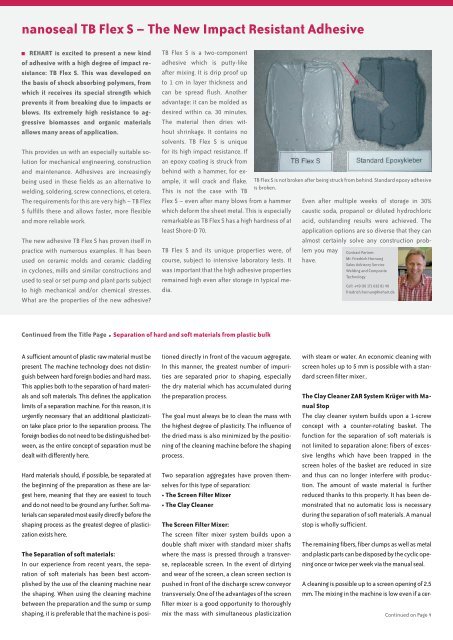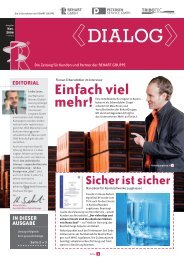DIALOG Issue 09/2010 (pdf-File) - Rehart GmbH
DIALOG Issue 09/2010 (pdf-File) - Rehart GmbH
DIALOG Issue 09/2010 (pdf-File) - Rehart GmbH
You also want an ePaper? Increase the reach of your titles
YUMPU automatically turns print PDFs into web optimized ePapers that Google loves.
nanoseal TB Flex S – The New Impact resistant Adhesive<br />
rEHArT is excited to present a new kind<br />
of adhesive with a high degree of impact resistance:<br />
TB Flex S. This was developed on<br />
the basis of shock absorbing polymers, from<br />
which it receives its special strength which<br />
prevents it from breaking due to impacts or<br />
blows. Its extremely high resistance to aggressive<br />
biomasses and organic materials<br />
allows many areas of application.<br />
This provides us with an especially suitable solution<br />
for mechanical engineering, construction<br />
and maintenance. Adhesives are increasingly<br />
being used in these fields as an alternative to<br />
welding, soldering, screw connections, et cetera.<br />
The requirements for this are very high – TB Flex<br />
S fulfills these and allows faster, more flexible<br />
and more reliable work.<br />
The new adhesive TB Flex S has proven itself in<br />
practice with numerous examples. It has been<br />
used on ceramic molds and ceramic cladding<br />
in cyclones, mills and similar constructions and<br />
used to seal or set pump and plant parts subject<br />
to high mechanical and/or chemical stresses.<br />
What are the properties of the new adhesive?<br />
A sufficient amount of plastic raw material must be<br />
present. The machine technology does not distinguish<br />
between hard foreign bodies and hard mass.<br />
This applies both to the separation of hard materials<br />
and soft materials. This defines the application<br />
limits of a separation machine. For this reason, it is<br />
urgently necessary that an additional plasticization<br />
take place prior to the separation process. The<br />
foreign bodies do not need to be distinguished between,<br />
as the entire concept of separation must be<br />
dealt with differently here.<br />
Hard materials should, if possible, be separated at<br />
the beginning of the preparation as these are largest<br />
here, meaning that they are easiest to touch<br />
and do not need to be ground any further. Soft materials<br />
can separated most easily directly before the<br />
shaping process as the greatest degree of plasticization<br />
exists here.<br />
The Separation of soft materials:<br />
In our experience from recent years, the separation<br />
of soft materials has been best accomplished<br />
by the use of the cleaning machine near<br />
the shaping. When using the cleaning machine<br />
between the preparation and the sump or sump<br />
shaping, it is preferable that the machine is posi-<br />
TB Flex S is a two-component<br />
adhesive which is putty-like<br />
after mixing. It is drip proof up<br />
to 1 cm in layer thickness and<br />
can be spread flush. Another<br />
advantage: it can be molded as<br />
desired within ca. 30 minutes.<br />
The material then dries without<br />
shrinkage. It contains no<br />
solvents. TB Flex S is unique<br />
for its high impact resistance. If<br />
an epoxy coating is struck from<br />
behind with a hammer, for example,<br />
it will crack and flake.<br />
This is not the case with TB<br />
Flex S – even after many blows from a hammer<br />
which deform the sheet metal. This is especially<br />
remarkable as TB Flex S has a high hardness of at<br />
least Shore-D 70.<br />
TB Flex S and its unique properties were, of<br />
course, subject to intensive laboratory tests. It<br />
was important that the high adhesive properties<br />
remained high even after storage in typical media.<br />
Continued from the Title Page Separation of hard and soft materials from plastic bulk<br />
tioned directly in front of the vacuum aggregate.<br />
In this manner, the greatest number of impurities<br />
are separated prior to shaping, especially<br />
the dry material which has accumulated during<br />
the preparation process.<br />
The goal must always be to clean the mass with<br />
the highest degree of plasticity. The influence of<br />
the dried mass is also minimized by the positioning<br />
of the cleaning machine before the shaping<br />
process.<br />
Two separation aggregates have proven themselves<br />
for this type of separation:<br />
• The Screen Filter Mixer<br />
• The Clay Cleaner<br />
The Screen Filter Mixer:<br />
The screen filter mixer system builds upon a<br />
double shaft mixer with standard mixer shafts<br />
where the mass is pressed through a transverse,<br />
replaceable screen. In the event of dirtying<br />
and wear of the screen, a clean screen section is<br />
pushed in front of the discharge screw conveyor<br />
transversely. One of the advantages of the screen<br />
filter mixer is a good opportunity to thoroughly<br />
mix the mass with simultaneous plasticization<br />
TB Flex S is not broken after being struck from behind. Standard epoxy adhesive<br />
is broken.<br />
Even after multiple weeks of storage in 30%<br />
caustic soda, propanol or diluted hydrochloric<br />
acid, outstanding results were achieved. The<br />
application options are so diverse that they can<br />
almost certainly solve any construction prob-<br />
lem you may<br />
have.<br />
Contract Partner:<br />
Mr. Friedrich Hornung<br />
Sales Advisory Service<br />
Welding and Composite<br />
Technology<br />
Cell: +49 (0) 171 632 81 49<br />
friedrich.hornung@rehart.de<br />
with steam or water. An economic cleaning with<br />
screen holes up to 5 mm is possible with a standard<br />
screen filter mixer..<br />
The Clay Cleaner ZAR System Krüger with Manual<br />
Stop<br />
The clay cleaner system builds upon a 1-screw<br />
concept with a counter-rotating basket. The<br />
function for the separation of soft materials is<br />
not limited to separation alone: fibers of excessive<br />
lengths which have been trapped in the<br />
screen holes of the basket are reduced in size<br />
and thus can no longer interfere with production.<br />
The amount of waste material is further<br />
reduced thanks to this property. It has been demonstrated<br />
that no automatic loss is necessary<br />
during the separation of soft materials. A manual<br />
stop is wholly sufficient.<br />
The remaining fibers, fiber clumps as well as metal<br />
and plastic parts can be disposed by the cyclic opening<br />
once or twice per week via the manual seal.<br />
A cleaning is possible up to a screen opening of 2.5<br />
mm. The mixing in the machine is low even if a cer-<br />
Continued on Page 4





